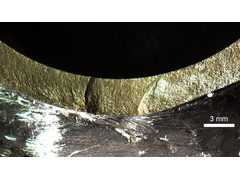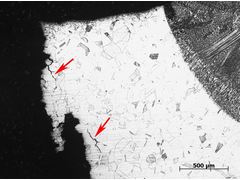

I do not know if you 've talked about this , but I found nothing in the forum .
Since I will have to change the frame of my Fury in many places , maybe I less work if I do it directly again .
My question is if I would have such disadvantages would be steinless steel as well at the highest price in the material and the fact that the material
is a bit more difficult to work with?
Don't do it - it will crack......quickly - had a brand new vinicator at the workshop with stainless chassis - cent end was almost cmpletely sheared off by the time it drove t the unit - not a good idea
Is it not a lot heavier too?
Best bet is to use the right material for the job then find the right solution to protect it from corrosion.
Too heavy, harder to work with if dIY and yes as mentioned will crack very quickly
Thanks for answers.
The weight would be the same .
No need to paint.
And in my opinion , slightly more resistant.
BUT : this is precisely what I wanted.People who have already made a similar esperienz.
The welds easily crack it already feel.I have my answer .
Thank you
This was discussed some 10 years ago if irc. It was a big no no for the cracking reasons mentioned above. No pun intended 
The idea of the steel frame is still.
if the tests that make them are definitely the deepest of my
http://www.silverfalcon.de/
If the welds crack that's not the parent metals fault, its the welding and the operators fault. I've built loads of structures in stainless carrying far load more then a car could place on it, never had a failure or a cracked weld.
Agree with above post. There are thousands of stainless steel tubular chassis Robin hood 2B's still rolling around quite happily. None of those have snapped apart the second they get on the road.
Mine has been on road for ten years now. Not a single crack but then again i welded it up. In my opinion will only crack if amps are to hot and welded over welds as this makes them brittle. There are pictures of my chassis in my archive
quote:
Originally posted by sprintB+
If the welds crack that's not the parent metals fault, its the welding and the operators fault. I've built loads of structures in stainless carrying far load more then a car could place on it, never had a failure or a cracked weld.
Just to clear up one issue raised:-
1 cubic metre of mild steel weighs 7850kg
1 cubic metre of 300 series SS weighs 7917kg
That's an increase of less than 1% ( 0.9% if you prefer )
quote:
Originally posted by Edwardo
Agree with above post. There are thousands of stainless steel tubular chassis Robin hood 2B's still rolling around quite happily. None of those have snapped apart the second they get on the road.
I think your asking:
1) Can I replace steel chassis members with stainless steel for a repaire. NO mixing steel and stainless in the same welded structure is asking for
rust at the steel/stainless welds...
2) Can I replace the steel chassis with a stainless steel ones? Not recommended the chassis would need to be designed to used Stainless Steel can be
done if the chassis is designed, but as your asking the question the short answer is no, the stainless as similar but not completely the same
mechanical properties as steel....
professional MIG/TIG welder I worked with many years ago built a trailer from stainless steel, having the right tools and welding facilities to do it. It didn't last long before cracking. He's since rebuilt from mild steel and powder coated it. The 2nd attempt has lasted 5+ years so far with no sign of damage or corrosion. As suggested I'd stick with mild steel and make sure to have it finished with something decent to stop the corrosion setting in.
quote:
Originally posted by Samuele
The idea of the steel frame is still.
if the tests that make them are definitely the deepest of my
http://www.silverfalcon.de/
All in all it seems that the safest thing would be to make the new iron frame and then powder coating.
And I think that is what I will do.
Thank you all
My only concern with powder coating is once it is finished than you can never drill any holes you also need to pre- drill all the hole for pop
rivoting your panels to size after powder coating was added. I used 2 packs chassis paint. make sure it is isosianate free
[Edited on 10/8/16 by axle]
my idea is as follows:
I want to do already the holes on all tubes.
then he will be welded the frame.
after usero of stainless steel inserts with thread M4.
I bought 100 pieces of titanium bolts m4x15 with the biggest head of the rule.
after what paint the telaio.nei the threads holes usero of high temperature resistant caps.
[img] [/img]
[/img]
[img] [/img]
[/img]
well you are right on the ball excellent
On a recent job at work we faced a number of failed pipe nipples at a gas plant (potential for a big bang)
Following this I spent a lot of hours finding out why and in the process learned a lot more about how low carbon stainless alloys behave.
At the lower end many stainless steels have a fairly high carbon content and are very similar in mechanical behavior to normal low carbon steel. What
they are though is very sensitive to to structural change from a whole host of variables but done correctly they are quite good at dealing with
vibration.
Problems mainly come from incorrect weld procedures and incompatible filler rods either from MIG, TIG, MMA or STT welding methods.
Incorrect Shielding during TIG / MIG. Using Common Argo Shield gas and not high purity Argon.
Excess heat input coupled with poor shielding makes the metal coke up on the back side or inside box section where you cant see. All these leave
sub-surface flaws or affects the grain structure where a crack can propagate. the speed of the crack growth is linked to the natural frequency of the
assembly matching that of the vibration source. Since in a car the vibration source frequency moves so much with revs / gears / road surface all the
ingredients for failure are there already.
The next part that affects the grain structure is contamination, any kind of containment left on the area being welded can melt and be sucked into the
weld pool, when it cools you have a different micro structure and beginning of a failure point. This failure point can like what was in our case not
even be in the weld pool but the edge of the heat effected zone.
Trying not to bore everybody but I found it fascinating, it turned out that our failed pipes were from residual contamination on the surface being
welded of a zinc based paint on adjacent pipes caused the subsurface cracking and loss of production in the facility close to $150m in the end.
Metallurgical analysis of the failed pipe nipple showed evidence that the failure was due to liquid metal embrittlement, with the liquid metal being
zinc. During the welding operation zinc residue from previous coatings in contact with the components being welded, melted, and diffused along grain
boundaries, lowering interfacial energies where present. At some point in time, most probably during weld cool down, the strain energy developed
caused cracks to initiate. Propagation of the initiated crack may have been promoted by continued diffusion, system static loads, cycling frequency
loads during operation of the unit.
So in short it can be used but the risk for out weighs the rewards, specially doing dissimilar welds of carbon steel to SS which can be done with the
right materials and procedures.
Macro Picture of the crack cross section


Picture of Crack
Electron Micro-graph of the sectioned crack


X-Ray
Higher Magnification, note the sub surface cracks which initiated the failure and sharp crystal formation


micrograph
molten zinc >416C and stainless steel do not go together well, see the outcome of the flixborough disaster.
Your micrographs are interesting, thanks
quote:
Originally posted by axle
My only concern with powder coating is once it is finished than you can never drill any holes you also need to pre- drill all the hole for pop rivoting your panels to size after powder coating was added.

